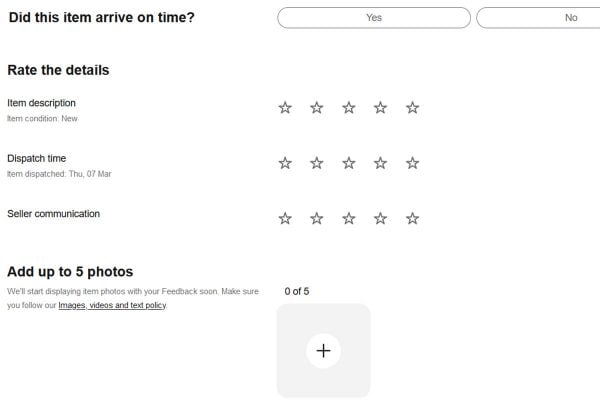The eBay UK Summer Seller Release saw continued changes and greater returns requirements for eBay merchants in certain new categories. We wrote about it here but specifically sellers in the Fashion, Health & Beauty, Home & Garden, Sports, Hobbies & Leisure, Media and Vehicle Parts & Accessories won’t be able to offer 14 day returns on sales and must opt for 30 day terms. Needless to say this has attracted the ire of affected merchants, but is that annoyance justified?
Every merchant will have a nightmare story about a troublesome buyer that has tested their patience. But it does often seem that these incidents are considered in isolation, rather than in the round, with all the very successful sales that must occur daily (if most sales weren’t entirely trouble-free eBay and Amazon, and most of retail, simply wouldn’t exist). Isolating the single extreme case doesn’t also appreciate the legitimate and credible returns case that buyers have and will often address to sellers in a reasonable manner.
What is certainly true is that returns of any kind, and perhaps more specifically the wrangling over returns with a difficult customer, is a greater problem for smaller merchants than the with more resources. It can also be incredibly frustrating and time-consuming.
But, perhaps crucially, one of the more interesting aspects of returns is the extent to which they are actually a sales tool. It’s interesting to reiterate one point that eBay made in its information to sellers. They said that they saw sellers who changed their policies from 14-day to 30-day experience an average 13% lift in their conversion rate.
That’s why eBay is concentrating on how shoppers can return the goods, of course. Buyers like the reassurance and confidence they engender and longer timings would seem to be more popular with buyers.
A crucial question must be whether offering longer periods does genuinely mean more cases, and we’re unsure about that, but suspect it’s unlikely. One Tamebay reader made a comment along similar lines on the post linked above related to increasing his terms to 30 days:
We have offered 30 day returns for some time, and had the same initial preconceived ideas that our returns rate would increase. In fact, this has not been the case.
– Tamebay reader James
What is your experience?











9 Responses
Several years ago we increased our returns from 14 to 30 days and saw a very small increase. Then we extended to 60 days and saw no change. We now offer 12 month returns and it made no difference. The number of returns we get past 30 days is tiny.
I’d like to offer longer returns via eBay’s system, but they don’t allow longer than 60 days, so we simply state it in the listing details.
We’re even considering offering perpetual returns as it’s potentially a good marketing hook and we don’t expect it to have any negative effect.
However, it’s worth saying that what we sell is almost always resellable and very rarely do we have to throw anything away and also the packaging is easily and cheaply replaced. I appreciate that this is not the case for many sellers, so everyone has to make their policy to fit their particular business.
I agree that our returns rate stayed roughly the same when we increased to 30 days. However, for some of our products, accepting returns up to 60 days would cause an issue, as many of our items have expiry dates, making them more difficult to sell as the end dates get longer.
We don’t sell fashion items, but I would imagine that could also be an issue as by the time some items were returned, the next season may have commenced..
We increased to 30 days and saw no real difference. Most customers have made up their mind in 14 days! We sell a lot of seasonal stuff so it was a worry that people would sit on stuff for ages then return when the sales season had finished… that didn’t happen.
It’s a bit like the 99p or £1 thing to customers… it’s actually a very small difference but in your mind it’s a lot!
How long does the average person want to keep an item that they do not want?
As mentioned above different business have different needs depending what they sell and at which end of the market they are at. If you look at someone like John Lewis who are a higher end retailer have a much more generous returns policy. I have stood behind customers in line who have said they dropped and broke and item yet JL swapped the item. If you went into Sports Direct or JD Sports you would be laughed out of the door if you tried that. As a business we should be given the choice if we want to offer minimum requirements or offer the red carpet treatment of longer periods and free returns no matter what. For some customers the returns policy might be the differentiating factor in which business they buy from.
ebay state “Our research shows that sellers could benefit from improved conversion with more competitive returns policies” Would be nice to see what the research they actually did. If you ask a customer would you like free returns and longer return period everyone would say yes.
If you ask which price would you pay:
£10 – 14 days returns and buy pays for returns or
£12 – 30 days returns and seller pays for returns
Customers tend to go for items on cost as lose count of the amount of emails I get a week asking for money off buy it now items.
Considering buyers can leave a negative within 60 days – and presuming you would like to avoid such negative – it might be wise to set returns for the same period of time ie 60 days.
As mentioned above we have seen no increase ” in returns with it set at 60 days but i would presume that it category and product dependant.
Returns in art and collectables would prove a problem over 60 days, people chancing their arm and buying for profit would have several weeks to sell the item at fairs or auction before returning at the sellers expense because they couldn’t make a profit. We’ve experienced this in 14 days, never mind 60.
Looking at the returns windows offered by our customers within the fashion sector, we found that 90% of customers returned within 16 days, even when the return window was up to 6 months.
Looking across the industry at brands like Addidas and Zalando, the 100-day return promise works as a hugely effective customer recruitment, without any real repercussions.
For more information about what shoppers want from a return experience, check the latest consumer research on our website! https://www.reboundreturns.com/ebooks-and-reports
-Fiona, Head of Customer Engagement at ReBOUND Returns